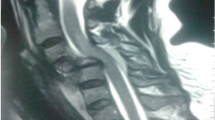Summary
A case of traumatic cervical spinal cord injury due to congenital craniocervical abnormalities is described. The autopsy revealed evidence of hyperextension of the neck due to frontal impact, congenital occipitalization of the atlas accompanied by basilar invagination of the odontoid process and atlanto-axial diastasis. The subsequent narrowing of the spinal canal led to a predisposition for this unusual mechanism of spinal cord injury.
Zusammenfassung
Ein Fall einer traumatischen Halsrückenmarkverletzung bei einem Mann mit kongenitalen craniocervikalen Fehlbildungen wird beschrieben. Die Autopsie zeigte Zeichen der Hyperextension des Halses infolge eines Frontalanpralls, eine angeborene Occipitalisation des Atlas, begleitet von einer basalen Invagination des Dens und einer atlanto-axialen Diastase. Die nachfolgende Einengung des Spinalkanals führte zu einer Prädisposition für diesen ungwöhnlichen Mechanismus einer Verletzung des Rückenmarks.
Similar content being viewed by others
References
Aboulker J, Metzger J, Harispe L, David M (1971) Malformations de la charnière cranio-rachidienne. Mécanisme des troubles neurologiques. In: Fischgold H, Metzger J, Légre J, Djindjian R, Engel P (eds) Traité de radiodiagnostic. Masson Paris, pp 115
Adams VI (1992) Neck injuries: I. occipitoatlantal dislocation — a pathologic study of twelve traffic fatalities. J Forensic Sci 37:556–564
Adams VI (1992) Neck injuries: II. atlantoaxial dislocation — a pathologic study of 14 traffic fatalities. J Forensic Sci 37:565–573
Burwood RJ, Watt I (1974) Assimilation of the atlas and basilar impression. Clin Radiol 25:327–333
Iannacone WM, DeLong WG Jr, Born CT, Bednar JM, Ross SE (1990) Dynamic computerized tomography of the occiputatlas-axis complex in trauma patients with odontoid lateral mass asymmetry. J Trauma 30:1501–1505
Iwata M (1975) Atlas and axis: congenital malformations of the upper cervical vertebrae. Neurol Med 3:295–310
McRae DL, Barnum AS (1953) Occipitalization of the atlas. Am J Roent 70:23–46
Saternus KS (1987) Bruchformen des Condylus Occipitalis. Z Rechtsmed 99:95–108
Shirasaki N, Okada K, Oka S, Hosono N, Yonenobu K, Ono K (1991) Os odontoideum with posterior atlantoaxial instability. Spine 16:706–715
Sievers KW, Löhr E (1988) Über eine seltene Fehlbildung des occipitocervicalen Oberganges. Fortschr Röntgenstr 148:334–335
Sievers KW, Dietrich U, Löhr E (1992) Radiologische Aspekte des Kraniozeruikalen Übergangs. Dtsch Med Wochenschr 117:1072–1077
Author information
Authors and Affiliations
Rights and permissions
About this article
Cite this article
Aragaki, Y., Takatsu, A. & Shigeta, A. Unusual mechanism of lethal cervical spinal cord injury in a case of atlanto-axial diastasis. Int J Leg Med 106, 41–43 (1993). https://doi.org/10.1007/BF01225023
Received:
Revised:
Issue Date:
DOI: https://doi.org/10.1007/BF01225023




